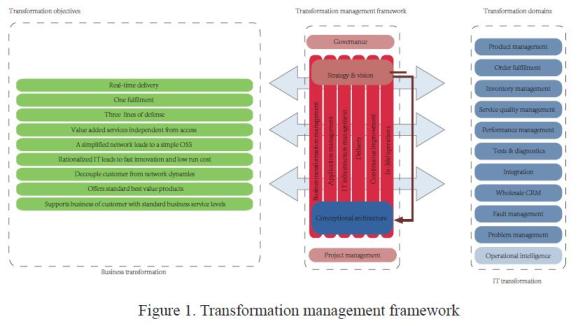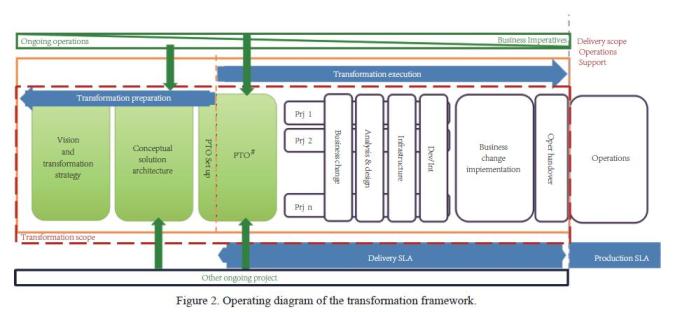Digital Transformation: Unleashing the Power of Telco

Business support systems (BSS) and operational support systems (OSS) are essential for the telecom industry. Their importance has increased in direct relationship with the expansion and sophistication of communication services. Traditionally, OSS is to manage telecom resources to guarantee services are efficiently delivered, while BSS components are oriented to support service commercialization by packaging network capacities and commercial conditions, assuring and improving operator revenue streams, and supporting customer relationship management. With their respective network platforms, both OSS and BSS are largely responsible on how end customers perceive the quality of services delivered by operators. This is commonly known as the customer experience.
Nowadays, digital economy is about constructing disruptive value and providing outstanding experience in the connected world. In such a context, the telecom industry has been heavily disrupted as a result of major technological and social evolution trends:
● Connectivity is perceived as a ubiquitous and affordable commodity. Traditional telco business model is declining.
● Individuals, enterprises as well as public institutions and global organizations are eager to use and produce all types of digital services to support and improve every aspect of human life.
● OTT and other digital services providers have consolidated their relationship with users in the digital world.
● Personal mobile devices with very important and increasing processing power are widely used.
● More and more competitive edge in the business landscape is achieved by a combination of disruptive technologies and business models, empowered by artificial insight into the processing of huge data volumes.
● Network providers are in network dilemma: data eagerness requires huge investments while carrier service providers (CSPs) get a small part of the benefits.
In spite of the current dominance of global OTT players, network services are essential for digital service development. A solution to the network dilemma will bring stability to the whole digital ecosystem. Digital transformation can allow CSPs to regain relevance in the digital arena, reengage in the growth, and provide a solid foundation for vigorous development of digital businesses.
To assure transformation objectives, operators need to address innovation, integration and monetization. Operators need to develop systematic innovation capabilities at three levels: business models, products, and operations. Business model innovation is the source of disruption capabilities as it allows redefining the way operators integrate and create value in the digital ecosystem. The innovation creates new value chains and ways of doing businesses by synthesizing business imperatives with emerging technologies. Product innovation allows operators to extend their market share and diversify their sources of revenue. Operation innovation focuses on doing more with less while creating the environment that facilitates business models and product innovation. In a digital economy, innovation is the engine, and the source of competitive edge relies in implementing systematic innovation. This makes partnership essential for a successful business strategy in the digital business. No single party is able to address all capabilities and capacities needed to maintain systematic innovation. Partnership allows service providers to leverage their own strengths and investments to produce massive and systematic innovation with controlled risk. Harnessing this vision requires service providers to provide simplified and automatic platforms that facilitate products and services integration provided by third parties. All this assures end-to-end QoS to an end consumer. It is also essential to develop the capabilities to easily and systematically monetize any participation in the value chain. The monetization capabilities shall support different business and pricing models.
Another important issue to be addressed by digital transformation is to protect scarce and expensive network resources while assuring customer experience. Service providers should develop the capabilities to dynamically optimize network resources, avoid overutilization and guarantee QoS.
Transformation is happening in the industry at different paces and with different results. The outcome of transformation processes will be the key to their competitive edge as winners will be those who manage to leverage their own strengths and investments with intensive partnership and innovative business models to provide a right blend of services and experience to their customers. Lean operational organizations and streamlined business processes powered by NG-BOSS architecture will allow CSPs to deliver new services, implement innovative business models, grow revenue, improve customer experience, and optimize resource utilization while lowering overall operational costs.
Digital transformation for CSPs is a complex process involving the orchestration of changes in organizations, business processes and the underlying technologies from a specific state to a target situation in a predefined period of time. The journey will be risky, with multiple dangers jeopardizing the success of the process. Hence the transformation process requires a thoughtful and careful preparation. The preparation should unify the vision of future organization and settle transformation expectations of stakeholders to assure organizational commitment, the right sponsorship, the collaboration of relevant areas, and necessary resources to carry on with the transformation process.
Before launching specific transformation activities, CSPs should focus on defining a clear transformation roadmap and comprehensive governance procedures for managing massive transformation activities, controlling internal and external interdependencies, and mitigating risks.
Transformation planning is not about predicting the future with a crystal ball, but rather about defining clear objectives and a consistent process to follow up the progress of transformation initiatives, identify contextual changes and provide a flexible framework for adjustment. The governance procedures should also implement a rigorous decision-making process based on deep understanding of the transformation process, impacts and potential benefits.
However, once transformation strategy, plans and governance procedures have been settled, speed is of the essence to achieve successful transformation. The faster to yield the foundation, the better to keep transformation momentum, that is, to probe benefits of target architecture, gain support from stakeholders and users, and to mitigate the risks associated to uncontrollable growth of legacy systems and customized product-oriented processes.
Strategic milestones are different from tactical milestones that are mostly driven by quick wins and technical insight to accelerate and secure the transformation process. The following are recommendations for securing and accelerating the transformation process from a tactical perspective:
● Minimize changes and evolution investments in legacy systems.
● Avoid as much as possible the burden and complexity generated by parallel processing.
● Define a single source of truth for data even during tactical stages.
● Use the integration layers of the target architecture to absorb the burden and complexity of temporary interfaces and parallel processing (if any).
● Implement formal communications channels with business areas, ongoing operations and other ongoing projects.
Although influenced by the choice of technical solutions, a successful transformation for CSPs has to be driven by business. This helps to fulfill business transformation objectives, provide a consistent decision process, and determine the real relevance of risks and opportunities that will popup during the transformation.
Defining the transformation approach involves settling expectations of stakeholders and unifying the vision of future operations. Clear transformation objectives, strategic roadmap principles and target conceptual architecture should be also defined. Issues to be addressed by the transformation strategy include business organization, business and operational processes, business products and services, conceptual solution architecture, and cost effectiveness.
The transformation approach needs to provide clear objectives, flexibility and control, and a convenient process to manage work teams, identify their responsibilities and accountabilities, and break down transformation objectives in manageable phases. A controlled process is also necessary to assure the quality and continuous improvement of the delivery process.
Moreover, the transformation approach needs to introduce flexibility in managing transformation roadmap as well as its investment predictability so as to take advantage of changes and opportunities that will occur in the execution.
The transformation approach can be divided in two major phases: platform preparation and project execution. A platform will be used for launching transformation initiatives in a controlled manner. A framework will also be implemented to assure business strategic focus and effective delivery. The framework will establish a link between transformation objectives and functional domains where the transformation is implemented (Fig.1).

The transformation framework is used by a program transformation office (PTO) to assure consistent evolution of all activities within the transformation program, control architectural decisions, and integrate initiatives and projects as a part of the transformation program. The transformation framework works with different elements of the two transformation phases, as illustrated in Fig.2.

Transformation preparation includes three elements: the vision and transformation strategy, conceptual solution architecture, and PTO setup for consolidating governance procedures.
During the project execution, PTO uses the framework to define the transformation roadmap and launch different projects that will be composed of a different blend of activities such as business change, analysis and design, infrastructure management, and development and integration. The result of all these projects is then handed over to operations. The approach also involves establishing formal channels to communicate with stakeholders about the transformation progress and to integrate inputs and changes coming from business areas in the form of business imperatives, ongoing operations and other ongoing projects outside the transformation program.
The transformation approach also manages the necessary collaboration between three different streams engaged to the same objectives but with different focuses. To assure delivery consistency, these streams should have end-to-end accountability of the transformation process in their respective domains.
● Business transformation stream: They own business transformation objectives and have deep understanding of existing processes and organization. They also have the mandate and resources to make changes across the organization.
● Design to deployment stream: They own the solution and have a solid understanding of business and operational environments. They also assure solution implementation according to the business transformation objectives.
● Build stream: They own the systems and have a deep knowledge of OOB functionalities and implementation options. They assure consistent functionality implementation based on native functions, and also provide tools and development capabilities to facilitate the implementation process.
ZSmart is a solution suite covering whole operation process domains for telecom operators. Drawing on ZTESoft’s rich industry experience and conforming to technological standards, ZSmart offers the most complete functional component packages that can be assembled and configured flexibly on the unified SOA infrastructure to quickly deliver new services. It can also be integrated with external systems to satisfy various market and customer demands.
ZSmart has been thoroughly designed to support fast implementation and deployment at low costs and risks, helping operators protect their investment and increase their reactivity to the ever-changing market.
ZSmart brings a brand-new architectural approach by providing flexible end-to-end business support through native orchestration and articulation of standard-based federated components and interfaces. With full-fledged business process management, integration, and operational support, the architectural approach guarantees incomparable flexibility and independence for customers and opens a wide new world of transformation and innovation opportunities for CSPs.